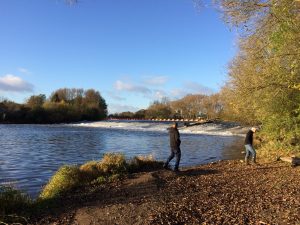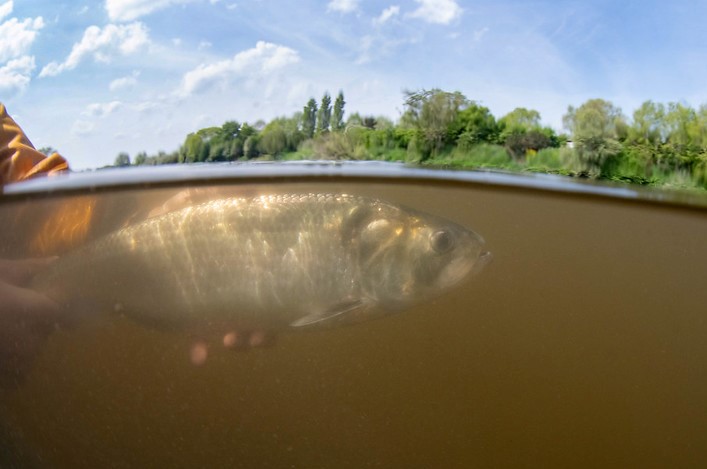
Header image by Jack Perks Wildlife Media
Charles Crundwell is the Senior Technical Specialist Fisheries at Environment Agency, and leads the Shad Monitoring Programme for Unlocking the Severn. Here he gives us an overview of this year’s 2021 shad run.
The 2021 shad run season has been unusual with unseasonal weather challenges for our shad monitoring programme. We started with a dry and cool April. There was just enough warmth to get the earliest arrivals of shad to appear in late April at Upper Lode Weir, Tewkesbury. Then, almost out of the blue the weather turned; by some statistics May became one of the coldest on record for the last 60 years. Low temperatures were also accompanied by persistent rain. The river levels rose up to high levels, over-topping the weir at Upper Lode and the notch where we normally observe shad passing over.
By the time the river levels finally came back down to normal levels the shad run was nearly over. However, every cloud has a silver lining, and these extreme events do provide us a chance to learn about how shad react to changing environments. Although we don’t have clear shad counting observations for the full run, we can gain new scientific insights to help build a richer picture of these fascinating fish and how they behave under different conditions.
Citizen Science: shad counting at Upper Lode, Tewkesbury
As in previous years, a group of trained citizen science volunteers were ready to observe shad passing the notch at Upper Lode Weir in Tewkesbury. Their count data helps us to estimate the shad run in 2021. In previous years we had managed to cover the whole run, with a clear view of shad passing over white boards placed over the notch in the weir. This year, we even replaced the white board to improve observations, and all was looking good as shad started to reappear at the end of April.
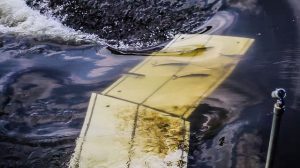
Shad passing over monitoring boards at Upper Lode Weir, Tewkesbury. Photography: Nina Constable Media.
Then the rain arrived! For weeks on end high river levels overtopped the weir. Even if the citizen scientists could see the boards, shad were not limited to passing via the notch and could have easily swum straight over above the flooded weir at any point along its length. So, we will not be able to estimate a complete shad run for the River Severn in 2021.
Conditions did eventually improve by the end of May and early June. Once again we got some good observations and data from the citizen scientists. These observations will provide an absolute minimum run estimate which is still really useful.
A camera at the Upper Lode Weir also records video footage. Online volunteers are welcomed to review the videos ON OUR WEBSITE and contribute important citizen science count data. When this data has been processed, we will get the best estimate we can of the shad run.
Insights from the new fish pass window at Diglis, Worcester
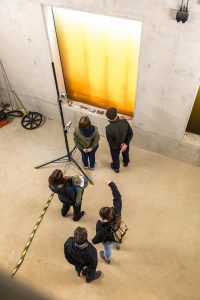

Visiting the Fish Pass Window. Photography credit: Barbara Evripidou. ©Barbara Evripidou/FirstAvenuePhotography.com
The citizen science monitoring for Upper Lode provides an incomplete picture this year, but the new fish pass at Diglis in Worcester does provide additional insights further upstream. Within the belly of the fish pass, an underwater window has been installed. Monitoring cameras have been recording footage of fish moving through the pass since 26th April. Two of the cameras are automatically motion-triggered to record a film clip as fish pass by the window. The other camera is continuously recording so that we can check the motion-sensitive cameras are working correctly.

One of the monitoring cameras recording footage from the Diglis fish pass window. Photography credit: Barbara Evripidou.
So far, an amazing 21 different species of fish have been detected swimming through the pass. Several thousand fish have been able to move upstream of this weir to spawn. The first species through were the dace and pike which spawn in cool water temperatures. Those that waited longer were bream and carp who prefer warmer temperatures. The first confirmed shad – a historic moment for the ecology of the River Severn – went through on the 9th of May. Although further film footage from earlier weeks remains to be reviewed, so this date may be revised. At the time of writing the project has counted several hundred shad go through, an exciting and encouraging result. As more film footage is reviewed, the count will be updated and a final figure available later in the year.
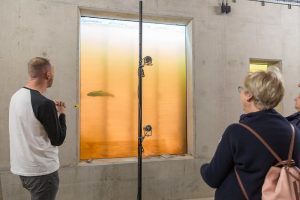

Diglis Fish Pass Window. Photography credit: Barbara Evripidou
Environmental DNA monitoring
Another technique our project has used to map distribution of shad involves taking water samples and testing it for environment DNA. All living organisms are shedding traces of their DNA into the environment all the time. Shad only enter freshwater for a few weeks each year, so the presence of the eDNA is a great way to see where the fish have reached in the river system.
We are working with Bournemouth University, as in previous years, who have taken a series of water samples throughout the River Severn as far as Lincomb weir (south of Stourport). Their results will not be available until the end of the summer, but in previous years this sampling has shown how much of an obstruction the navigation weirs are to shad. With Diglis weir fish pass now open and with confirmed shad going through it, it will be super interesting to see how distribution has changed from previous years. Particularly as we can now confirm from the viewing gallery the time and number of fish passing upstream.
Acoustic tags: monitoring the movement of individual fish
Up to this point in the project (2017-2020) we had acoustically tagged 209 shad. Our next goal was to increase this number by 100 in 2021. The weather seriously hampered this aspiration, but not all was lost.
We had a new trap specially designed for capturing shad as they pass over Upper Lode weir. This new trap worked beautifully. Even with low numbers of shad running at the end of April, we were able to catch enough shad to tag 77 individuals. 44 of these were tagged with an acoustic tag containing a battery, allowing us to monitor their movements for up to three years. The remainder were tagged with a passive Integrated Transponder tag (PIT tag). This does not have a battery, but is read much like a microchip in a cat or dog. As shad pass through energised PIT tag loops (more on this later) each individual fish is detected and recorded.
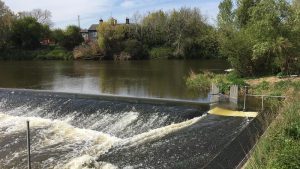
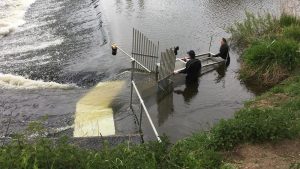
Acoustic tagging at Upper Lode Weir
Our contractors from Hull University did also tag a further 3 shad at the end of May when the river conditions improved. However, by then it seemed likely the majority of shad had already passed upstream so we stopped any additional tagging attempts.
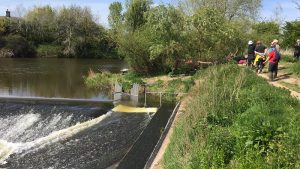
Volunteers witness the first sighting of shad, at Upper Lode Weir
Reporting our findings
Tagged fish give a wealth of data on movements in river and ultimately out at sea. This year we have a new PhD student Mark Yeldham who is coordinating all these detections. He is adding to the 3 years’ work undertaken by our previous PhD student, who successfully completed his PhD research thesis earlier this year. Only some of his research has been published publicly so far, and we wait with interest for further papers.
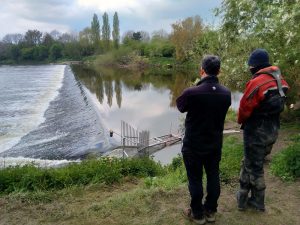
Volunteers at our fish tagging site at Upper Lode Weir.
Mark is currently downloading data from the 50+ acoustic receivers positioned throughout the River Severn and will report back on findings in September. But we understand that shad have successfully passed up the river Teme and also quickly approached Diglis weir. In fact, we have another independent confirmation that the fish passage improvements on the river Teme are working. A shad was captured accidently by an angler towards Tenbury at the start of the fishing season in mid-May. The shad was safely returned and this shows that shad are penetrating far up the river Teme again.
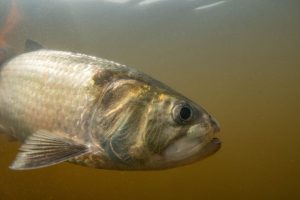
A shad up close! Photography credit: Jack Perks Wildlife Media.
How will shad have reacted to this year’s river conditions?
What will be particularly interesting to learn from this year’s data is how all the acoustically tagged fish reacted to the elevated flows and cold spring conditions. Did they use the high flows to migrate upstream? Or did they drop downstream waiting for more favourable conditions? Also, if the river was too cold to spawn what did they do? They might have waited for the river to warm up, dropped back downstream for a while or even abandoned attempts at spawning for the year. It will be fascinating to find out more about how shad behaved in this year’s extreme conditions.
Shad at Sea
What we do already know is that one of our fish tagged in 2021 has already been detected post spawning off the south Wales coast. We expect many more detections in the marine environment through collaboration with Swansea University in the coming months. We also know that 14 of the shad that were originally tagged in 2019 returned for their third year in 2021. This allows the project to consider how prevailing flow and temperature conditions on the river affects migration changes between years.
PIT Tags
I mentioned earlier that all our fish contain a PIT tag. There are two reasons why we put these tiny tags in the fish. The first is so we can recognise shad that we have caught previously so we don’t attempt to tag them again. The chances of catching the same shad in different years are minuscule. But amazingly this happened in 2021, with a lovely shad caught in the trap at Upper Lode turning out to be a fish we had tagged previously. After taking a quick photograph and measurements for our records we released the fish to continue on its merry way.
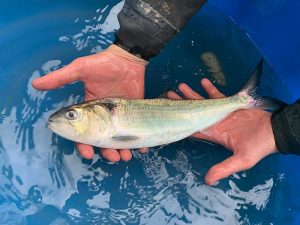
Twaite shad held by monitoring scientists during one of our fish tagging exercises.
The other specific reason to PIT tag fish is to help test fish pass efficiencies. By putting a series of PIT tag loops thorough the newly constructed fish pass at Diglis it is possible to see what proportion of shad approach the fish pass, how many enter and how many successfully pass upstream. Even with the reduced number of shad tagged in 2021, tagged fish have reached and passed upstream of the new fish pass. We plan to repeat this experiment in 2022.
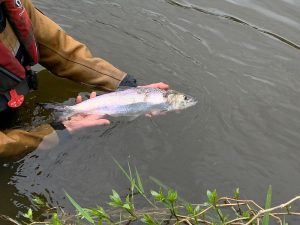
Shad released back into the River Severn after acoustic tagging.
It will be really interesting to see:
– how many of these pioneer shad successfully pass through
– the length of time it takes them to negotiate the fish pass
– how much individual variation there is in their behaviour using the path
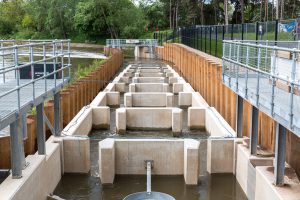
View from Diglis Fish Pass. Photography Credit Barbara Evripidou.
Spawning Watch
The final part of our shad monitoring in 2021 was the spawning watch. Shad make a very distinctive splashing noise at night as they spawn. It makes a noise similar to swishing your hand round in a circulation motion to get bubbles to form when making a lovely bubble bath. This noise goes on for a few seconds when shad spawn and is very distinctive. The literature suggests that shad need a water temperature of around 16 degrees to spawn. Unfortunately for most of May the river did not reach these temperatures.
Our Volunteering Officer, Rachel Davies had placed a series of automatic listening stations out to record this night-time activity. Volunteers also attended a number of these sites overnight to validate these recordings. She and the volunteers heroically sat out into the small hours, on many nights with no splashy sounds to reward them. Although in science, a nil result is valid and useful data!
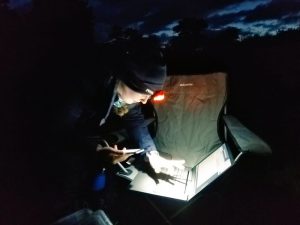
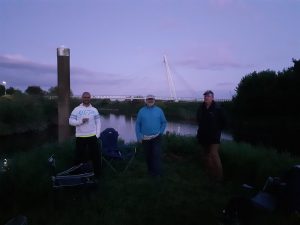
Rachel and some of our volunteers at a Spawning Watch event.
What appears to have happened is that once the river finally warmed up the shad were very actively spawning, but only for a very short period. Until we bring all the tracking data, run estimates and Diglis viewing data together we really do not know if it was either a poor year for spawning, or just concentrated over a few days rather than spread out over May.
We’ll have to wait and see!
This year may yet turn out to be a good year for juvenile shad recruitment (i.e. a high number of new, young shad returning out to sea). This is because the warm and relatively dry conditions from June onwards have actually been quite favourable for these tiny shad to thrive and grow. We will have to be patient to find out, as this year’s new generation of shad won’t return to the River Severn to spawn until they are mature in another 4-5 years’ time.
Summary
In summary, it has been a very tricky year for our monitoring programme, but I am expecting some amazing results in the coming months. Finally, on behalf of the whole project, we extend a huge thank you to the project team, the citizen scientists, volunteers and contractors for their tremendous efforts this year.
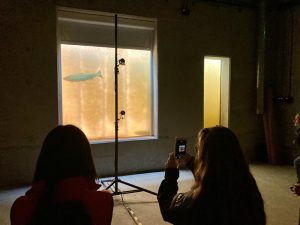
A salmon swimming past the Fish Pass Window at Diglis.


